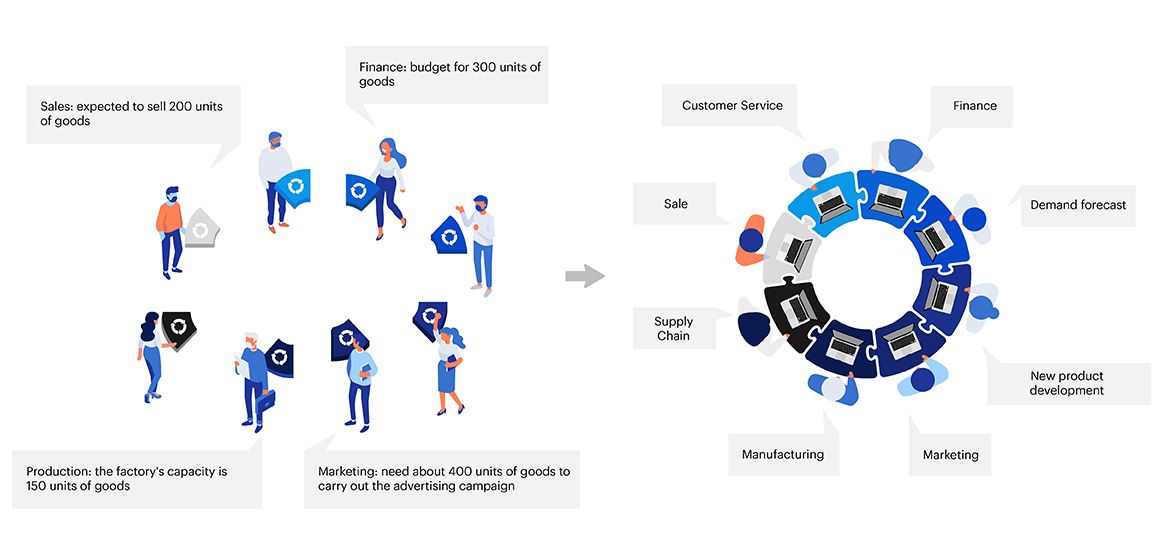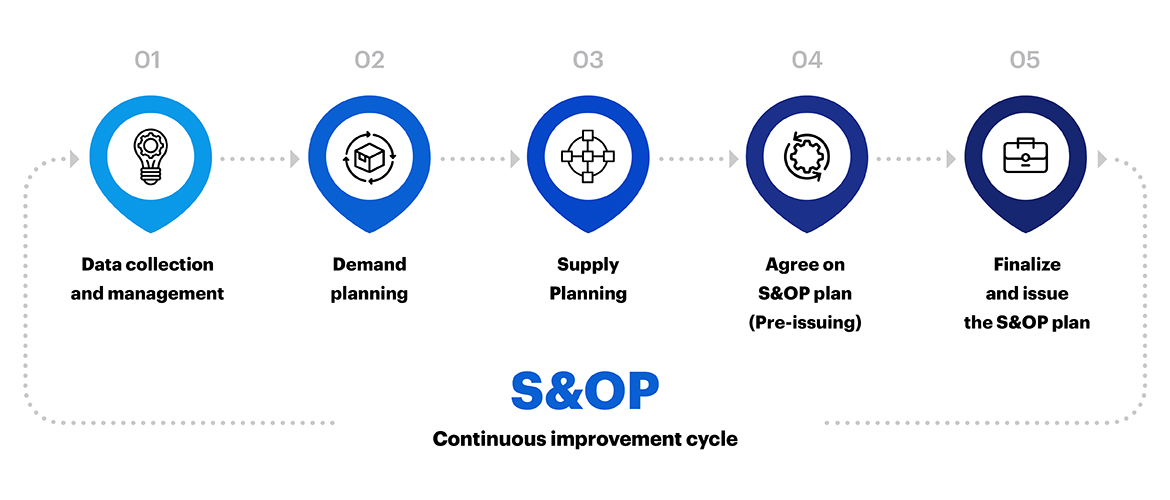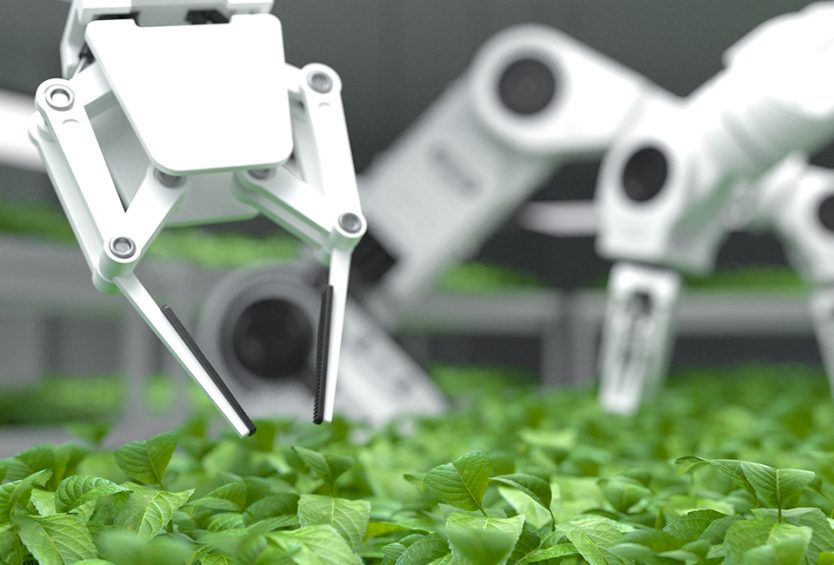Improved forecasting accuracy, increased planning and resource allocation efficiency by leveraging data, and cross-departmental planning are potential benefits that S&OP solutions bring to manufacturing enterprises in the new era.
In manufacturing, planning and balancing resources for the implementation of the plan are considered the most important factors. However, in reality, most businesses do not have enough information and forecasts for planning, which is mainly based on historical data and empirical forecast estimates. At the same time, the link between the overall business plan and the implementation plan of the departments is not high.
These factors lead to the risk of imbalance, difficulty in flexibility and adjustment between supply capacity and market demand. From there, businesses easily face the risk of lack of goods for delivery, untimely delivery, the risk of losing customers as well as unoptimized production resources, the risk of backlog of inventory and raw materials, etc. These difficulties are common in many manufacturing companies, especially large enterprises with a complex operating structure consisting of many departments.
S&OP solution is considered the key to overcoming the above difficulties thanks to the synthesis and unification of data throughout the enterprise.
What is S&OP, why is S&OP important?
Integrated Sales and Operations Planning (S&OP) is a process of gathering and connecting the individual plans of business chain departments such as sales, marketing, manufacturing, and finance. supply, … into a unified integrated plan throughout the enterprise.
This important management process determines the quantity of products to be produced, when to produce, the resources to be prepared, etc., based on the forecast of market demand, internal resources and strategic objectives of the enterprise.

Contrary to the individuality of traditional planning, the S&OP solution offers a new way of doing things based on coordination among departments in the business. Instead of a prediction process that only uses data of a certain type of product, S&OP is based on a big comprehensive picture with data from many sources: Manufacturing, market, customers, etc. closer to reality, closely integrating aspects of supply chain planning such as inventory planning, demand planning and supply planning.
At the same time, it provides an overview to help management easily see the problem and make business decisions. Thus, it can be said that S&OP is a powerful lever to help businesses improve customer service quality and optimize resources. Thereby achieving strategic goals and maintaining competitive advantage.
How does the S&OP model work?
S&OP planning in a manufacturing enterprise typically consists of five steps, chaired by senior management and conducted every month to ensure timely adjustments to market conditions. While the specific process may vary from business to business, it still includes key steps to follow.
Five Steps of Planning developed by Thomas Wallace and Robert Stahl – these two researchers are co-authors of the Sales & Operations Planning Handbook, a popular handbook on integrated operations and sales planning:
1. Data collection and management
Collect information about sales, sales volume, and historical inventory, … analyze trends to make forecasts, analyze Pareto to allocate forecast parameters. This is also the period to update the actual information compared to the previous forecast, to determine whether the plan made earlier is on the right track or not.
2. Demand planning
The phase of creating and adjusting long-term sales forecasts is at the beginning of each month. These forecasts are based on statistics that take into consideration historical demand or factors such as new product launches, promotional plans, customer tastes, market conditions, etc.
During this stage, new product development should be given a lot of consideration as they have an impact on the forecast results due to the lack of historical information. This phase should involve Management Board for early detection of threats, as well as Product Development, Sales, Supply Chain, Finance and Customer Service managers to ensure the multidimensional view of needs.
3. Supply planning
Assess the ability to meet demand, identify expected imbalances in supply and demand, thereby creating a supply chain plan that considers factors such as production capacity, inventory, suppliers’ capacity, financial ability, etc. Doing all of these requires the participation of accounting managers, supply departments, manufacturing department before moving to the next stage.
4. Agree on S&OP plan (Pre-issuing)
Unify supply and demand plans with financial plans. This is the stage where all stakeholders must participate, discuss the factors causing the imbalance, come up with solutions and agree on the overall operating plan of the organization.
5. Finalize and issue the S&OP plan
Complete the plan and issue it for implementation, this stage handles the remaining issues, the departments ensure resources so that the plan can be implemented well.

Factors affecting successful S&OP implementation
With the values it brings, S&OP is the top choice to improve the productivity and performance of a manufacturing business. According to the consulting experience of FPT Digital, manufacturing enterprises need a model of coordination and consensus among all departments, especially require strong participation from the top leaders as a factor to ensure the level of consistency between the company’s strategic plan and each department’ plans.
In addition, the IT platform and application system to connect activities throughout the chain, support transparency, collect and analyze data on operations, sales, production, warehouse, marketing, etc. are also important factors which will act as a basis for making highly accurate forecasts and supporting management information for the Board of Directors.
Case Study
S&OP models have been around since the 1980s and have proven their value over the years. One of the successful cases can be mentioned Sunsweet Growers – the world’s largest producer of dried fruit.
More than a decade ago, Sunsweet Growers noticed a growing supply chain spending problem affecting overall business results. The main reason was identified as ineffective planning leading to wasted resources and increased operating costs.
Sunsweet Growers has implemented a technology capacity building program as the foundation, and applied integrated planning (S&OP) methodology, resulting in many great successes such as increased forecasting accuracy by 15 – 20%, decreased 30% in finished product damage, the number of warehouses in the United States is reduced from 28 to only 8 warehouses (*).
Through the analysis of S&OP and proven results by data, it can be seen that the planning and application of S&OP can be considered as the key to unlocking breakthrough growth potential for manufacturing enterprises.
To prepare the most effective S&OP conditions and applications, businesses need to clearly prioritize strategic business goals, assess the current situation to adjust the planning coordination model among departments in the value chain, and at the same time, develop a strategy to apply digital technology and collect data as the foundation for the S&OP planning solution.
Besides, it is indispensable for the human factor to be communicated to change awareness and improve the level of consensus and coordination among employees in the enterprise. The work of assessing the current situation and developing a strategy for the application of S&OP requires multi-dimensional analysis, so businesses should consult a team of experienced experts to ensure proper planning and successful application implementation.
Reference
(*) Logistics Bureau. 2019 – 7 Mini Case Studies: Successful Supply Chain Cost Reduction and Management.



